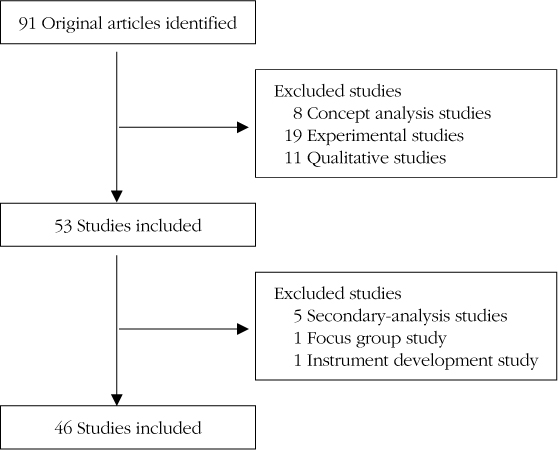Korean J Women Health Nurs.
2014 Dec;20(4):287-296. 10.4069/kjwhn.2014.20.4.287.
Analysis of Reports on Observational Studies Published in the Korean Journal of Women Health Nursing based on the STROBE Guideline
- Affiliations
-
- 1College of Nursing, Nursing Policy Research Institute, Yonsei University, Seoul, Korea.
- 2Department of Nursing, Chosun University, Gwangju, Korea.
- 3College of Nursing, Ajou University, Suwon, Korea. songje@ajou.ac.kr
- 4Department of Nursing, Semyung University, Jecheon, Korea.
- 5College of Nursing, Chungnam National University, Daejeon, Korea.
- 6College of Nursing, Jeju National University, Jeju, Korea.
- 7Department of Nursing, Dong-Eui University, Busan, Korea.
- 8Department of Nursing, Sangji University, Wonju, Korea.
- KMID: 2308162
- DOI: http://doi.org/10.4069/kjwhn.2014.20.4.287
Abstract
- PURPOSE
The purpose of this study was to analyze the quality of reports on observational studies published in the Korean Journal of Women Health Nursing (KJWHN).
METHODS
Forty-six studies using cross-sectional designs published in KJWHN from January 2011 to June 2013 were selected for analysis. Selected articles were reviewed and evaluated by three reviewers using the 22 items of the Strengthening the Reporting of Observational studies in Epidemiology (STROBE) statement. As some of 22 items had more than one check point, further broken down, 34 checklist items were used for analysis.
RESULTS
Overall, the reviewed studies provided sufficient descriptions for many STROBE items. Seven of the 34 items were found to be not applicable, and 15 of the remaining 27 items (55.5%) were evaluated as 'sufficient' in reporting. Only one study included a flow diagram illustrating participation and this lack of flow diagram was the weakest area of reporting in this review.
CONCLUSION
Clearer reporting of cross-sectional studies can be attained by attention to vulnerable areas of reporting, such as including a flow diagram of participants, descriptions of sources of bias and reason for non-participation, and describing limitations of the study. Issues regarding the application of STROBE statement items should be actively discussed in order to aid future revision and clarification of items included in STROBE statement.
Figure
Cited by 2 articles
-
Trend Analysis of Research Articles Published in the Korean Journal of Women Health Nursing from 2013 to 2017
Young Jin Lee, Seo Yun Kim, Saem Yi Kang, Yoo Jeong Kang, Lan Jin, Hee Yoen Jung, Hae Won Kim
Korean J Women Health Nurs. 2018;24(1):90-103. doi: 10.4069/kjwhn.2018.24.1.90.Strategies to improve the quality of reporting nursing research
Ju-Eun Song
Korean J Women Health Nurs. 2022;28(2):77-82. doi: 10.4069/kjwhn.2022.06.08.1.
Reference
-
1. Kim JI, Park SM, Park HS, Chung CW, Ahn SH. Analysis of published papers and their keywords in the Korean Journal of Women Health Nursing (2003-2006). Korean J Women Health Nurs. 2007; 13(1):51–59.
Article2. Kim JI, Lee EH, Kang HS, Oh HE, Lee EJ, Jun EM, et al. Analysis of published papers by keywords and research methods in the Korean Journal of Women Health Nursing (2007~2009). Korean J Women Health Nurs. 2010; 16(3):307–316.
Article3. Chung CW, Kim JI, Park HS, Ahn SH, Cho DS, Park SM. Analysis on report of statistical testings for mean differences. Korean J Women Health Nurs. 2007; 13(3):211–218.4. Cho DS, Chung CW, Kim JI, Ahn SH, Park SM, Park HS. Analysis on report of statistical testings for correlation and regression. Korean J Women Health Nurs. 2008; 14(3):213–221.5. Lee EJ, Lee EH, Kim JI, Kang HS, Oh HE, Jun EM, et al. Analysis of the correlation and regression analysis studies from the Korean Journal of Women Health Nursing over the past three years (2007~2009). Korean J Women Health Nurs. 2011; 17(2):187–194.
Article6. Jun EM, Lee EH, Kim JI, Kang HS, Oh HE, Lee EJ, et al. Analysis on report of statistical testings for mean differences in Articles in the Korean Journal of Women Health Nursing. Korean J Women Health Nurs. 2011; 17(4):388–394.7. Lee EJ, Song JE, Kim M, Kim S, Jun EM, Ahn S, et al. Analysis on reports of qualitative researches published in Korean Journal of Women Health Nursing. Korean J Women Health N. 2012; 18(4):321–332.
Article8. Kim MR, Kim MY, Kim SY, Hwang IH, Yoon YJ. The quality of reporting of cohort, case-control studies in the Korean Journal of Family Medicine. Korean J Fam Med. 2012; 33(2):79–88.
Article9. Kim MH, Cheon SH, Jun EM, Kim S, Song JE, Ahn SH, et al. The qualtity of reporting of intervention studies in the Korean Journal of Women Health Nursing (KJWHN): Based on the TREND guidelines. Korean J Women Health Nurs. 2013; 19(4):306–317.10. von Elm E, Altman DG, Egger M, Pocock SJ, Gøtzsche PC, Vandenbroucke JP. The strengthening the reporting of observational studies in epidemiology (STROBE) statement: Guidelines for reporting observational studies. Epidemiology. 2007; 18(6):800–804.
Article11. Vandenbroucke JP, von Elm E, Altman DG, Gøtzsche PC, Mulrow CD, Pocock SJ, et al. Strengthening the reporting of observational studies in epidemiology (STROBE): Explanation and elaboration. Int J Surg. Epub 2014 July 18.12. da Costa BR, Cevallos M, Altman DG, Rutjes AW, Egger M. Uses and misuses of the STROBE statement: Bibliographic study. BMJ Open. 2011; 1(1):e000048.
Article13. Moher D, Hopewell S, Schulz KF, Montori V, Gøtzsche PC, Devereaux PJ, et al. CONSORT 2010 explanation and elaboration: Updated guidelines for reporting parallel group randomised trials. Int J Surg. 2012; 10(1):28–55.
Article
- Full Text Links
- Actions
-
Cited
- CITED
-
- Close
- Share
- Similar articles
-
- Quality of Cohort Studies Reporting Post the Strengthening the Reporting of Observational Studies in Epidemiology (STROBE) Statement
- The Quality of Reporting of Cohort, Case-Control Studies in the Korean Journal of Family Medicine
- Analysis on Reports of Qualitative Researches Published in Korean Journal of Women Health Nursing
- The Quality of Reporting of Intervention Studies in the Korean Journal of Women Health Nursing (KJWHN): Based on the TREND Guidelines
- Analysis of Published Nursing Research on Women's Health : 1988-1997


